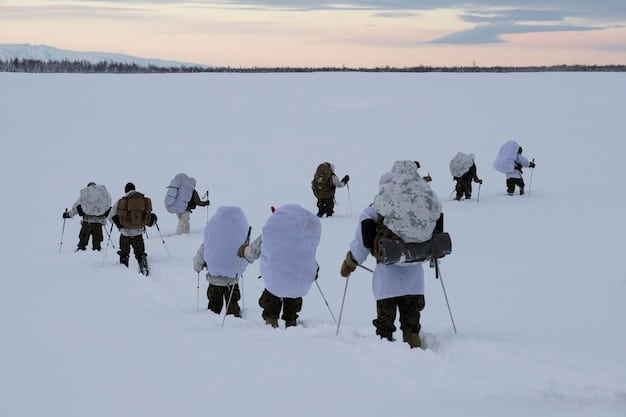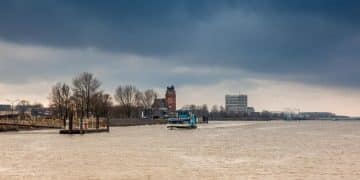US Arctic Priorities: Navigating Security, Climate, and Cooperation

The key priorities of the US in the Arctic region encompass safeguarding national and economic security, addressing climate change impacts, promoting international cooperation, and supporting sustainable development for Arctic communities.
The Arctic region is undergoing rapid and profound changes. For the United States, understanding and responding to these shifts is crucial. What are the Key Priorities of the US in the Arctic Region? This involves balancing national security concerns with environmental stewardship and international collaboration.
Understanding the Strategic Importance of the Arctic
The Arctic’s strategic importance has grown substantially in recent years. This is due to a combination of factors, including climate change, resource competition, and evolving geopolitical dynamics. A clear understanding of these factors is essential for comprehending the US approach to the region.
Geopolitical Shifts in the Arctic
The Arctic is no longer a remote and isolated region. It’s increasingly becoming a focal point for global powers. Several nations, including Russia and China, have been increasing their presence and activities in the area.
- Russia’s military buildup: Russia has been investing heavily in military infrastructure in the Arctic, raising concerns among other Arctic nations.
- China’s growing interest: China, while not an Arctic nation, has declared itself a “near-Arctic” state and has been expanding its economic and scientific activities in the region.
- Increased competition for resources: As the ice melts, access to valuable resources like oil, gas, and minerals becomes easier, leading to potential competition.
These geopolitical shifts necessitate a strong and proactive US presence in the Arctic. This includes maintaining a credible military presence, promoting diplomatic engagement, and working with allies to ensure a stable and peaceful Arctic region.
In conclusion, recognizing the rising geopolitical stakes and the emerging competition for resources is fundamental to understanding the US’s strategic calculations in the Arctic. A proactive approach, combining military readiness with diplomatic engagement, is vital for maintaining stability in the region.
Protecting US National and Economic Security

A core US priority in the Arctic is safeguarding national and economic security. This encompasses protecting US territory, maintaining freedom of navigation, and ensuring access to vital resources. The rapidly changing Arctic landscape presents both opportunities and challenges in this regard.
Maintaining a Military Presence
A robust military presence is crucial for deterring potential threats and ensuring freedom of navigation in the Arctic. This includes naval assets, air capabilities, and ground forces trained to operate in extreme cold conditions.
The US military presence in the Arctic serves multiple purposes:
- Deterrence: Deterring potential adversaries from engaging in hostile activities.
- Maritime security: Ensuring the safe passage of commercial and military vessels through Arctic waters.
- Search and rescue: Providing assistance to vessels and individuals in distress.
In addition to a strong military presence, the US is also investing in infrastructure improvements in the Arctic. This includes upgrading ports, airfields, and communications facilities to support military operations and civilian activities.
In short, sustaining a credible military presence, bolstering infrastructure, and developing specialized capabilities are essential components of the US strategy to protect its national security interests in the Arctic. A robust security posture enhances the US’s ability to deter threats, protect its assets, and ensure freedom of navigation in the region.
Addressing the Impacts of Climate Change
Climate change is profoundly impacting the Arctic region, causing sea ice to melt at an alarming rate, glaciers to recede, and permafrost to thaw. These changes have far-reaching consequences for the environment, ecosystems, and human communities. For the US, addressing the impacts of climate change in the Arctic is a critical priority.
The Urgency of Climate Action
The Arctic is warming at a rate twice as fast as the global average. This rapid warming is driving significant environmental changes, including:
- Sea ice decline: The extent of sea ice has been declining rapidly, opening up new shipping routes but also disrupting traditional ways of life for indigenous communities.
- Permafrost thaw: Thawing permafrost releases greenhouse gases, accelerating climate change and damaging infrastructure.
- Coastal erosion: Rising sea levels and thawing permafrost are causing increased coastal erosion, threatening communities and ecosystems.
To address these challenges, the US is committed to reducing greenhouse gas emissions, investing in renewable energy technologies, and working with international partners to mitigate climate change.
Ultimately, taking decisive action to mitigate climate change is essential for protecting the Arctic environment, supporting Arctic communities, and ensuring a sustainable future for the region as a whole. The US recognizes the urgency of this challenge and is committed to playing a leading role in global climate action.
Promoting International Cooperation
The Arctic is a region of shared interests and responsibilities. Given the complex challenges and opportunities in the Arctic, international cooperation is essential for promoting stability, managing resources, and protecting the environment. The US recognizes the importance of working with other Arctic nations, as well as indigenous communities and other stakeholders, to achieve common goals.

The Role of the Arctic Council
The Arctic Council is the primary intergovernmental forum for addressing issues related to the Arctic. It provides a platform for dialogue, cooperation, and consensus-building among the eight Arctic states: Canada, Denmark, Finland, Iceland, Norway, Russia, Sweden, and the United States.
The Arctic Council addresses a wide range of issues, including:
- Environmental protection: Protecting the Arctic environment from pollution and other threats.
- Sustainable development: Promoting sustainable economic and social development for Arctic communities.
- Indigenous issues: Addressing the rights and concerns of indigenous communities.
The US is committed to working constructively within the Arctic Council to address these challenges and promote a peaceful and prosperous Arctic region.
In conclusion, international partnerships are vital for addressing the complexities of the Arctic. The US champions collaborative approaches through the Arctic Council, ensuring that decisions are made collectively and that the interests of all stakeholders are considered.
Supporting Sustainable Development for Arctic Communities
The Arctic is home to diverse communities with unique cultures and traditions. Supporting sustainable development for these communities is a key US priority. This involves promoting economic opportunities, protecting cultural heritage, and ensuring access to essential services.
Addressing the Needs of Indigenous Peoples
Indigenous peoples have lived in the Arctic for thousands of years and have a deep connection to the land and sea. Their traditional knowledge and perspectives are invaluable to understanding and managing the Arctic environment.
Supporting indigenous communities involves:
- Protecting their rights: Ensuring that their rights are respected and protected.
- Promoting economic opportunities: Supporting sustainable economic development that benefits indigenous communities.
- Preserving cultural heritage: Protecting their languages, traditions, and cultural heritage.
The US is committed to working in partnership with indigenous communities to address their needs and promote their well-being.
Ultimately, promoting sustainable development and respecting indigenous rights form the bedrock of a just and equitable Arctic policy. By ensuring Arctic communities thrive, the US reinforces its commitment to a prosperous and inclusive future for the region.
Balancing Conservation and Resource Management
The Arctic holds significant natural resources, including oil, gas, minerals, and fisheries. Balancing the need for resource development with the imperative to protect the environment is a complex challenge. The US is committed to managing Arctic resources in a sustainable and responsible manner.
Sustainable Resource Development
The US approach to resource management in the Arctic is guided by the principles of sustainability, transparency, and environmental stewardship. This includes:
- Conducting thorough environmental impact assessments: Assessing the potential environmental impacts of resource development projects.
- Implementing strict environmental regulations: Ensuring that resource development activities are conducted in an environmentally responsible manner.
- Consulting with stakeholders: Engaging with indigenous communities, local communities, and other stakeholders in resource management decisions.
The US recognizes that sustainable resource development can bring economic benefits to Arctic communities, but it also recognizes the need to protect the environment and ensure that resources are managed responsibly for future generations.
To summarize, by integrating environmental safeguards with responsible resource extraction practices, the US aims to strike a balance that supports both economic growth and the long-term health of the Arctic ecosystem. This balanced approach underscores the commitment to preserving the Arctic’s natural heritage while responsibly utilizing its resources.
| Key Aspect | Brief Description |
|---|---|
| 🛡️ Security | Maintaining a military presence and protecting US interests. |
| 🌍 Climate | Addressing climate change and its impact on the Arctic. |
| 🤝 Cooperation | Promoting international cooperation through the Arctic Council. |
| 🌱 Sustainability | Supporting sustainable development for Arctic communities. |
FAQ
▼
The Arctic Council is an intergovernmental forum promoting cooperation among Arctic States, indigenous communities, and other stakeholders on issues of sustainable development and environmental protection in the Arctic.
▼
The Arctic is important to the US for reasons including national security, economic interests, environmental preservation, and the well-being of Arctic communities, including indigenous peoples.
▼
Climate change is causing rapid warming in the Arctic, leading to sea ice melt, permafrost thaw, and alterations in ecosystems and weather patterns, posing significant challenges to the area.
▼
The US is working to reduce greenhouse gas emissions, invest in clean energy technologies, and collaborate internationally to mitigate the effects of climate change in the Arctic region.
▼
Economic opportunities in the Arctic include resource exploration, shipping and transportation, tourism, and sustainable development projects that aim to support the growing Arctic economy.
Conclusion
In conclusion, the US’s priorities in the Arctic region underscore a commitment to safeguarding national interests while addressing the global challenges presented by climate change. By balancing security measures with sustainable development and fostering international cooperation, the US aims to ensure a stable, prosperous, and environmentally sound future for the Arctic.





